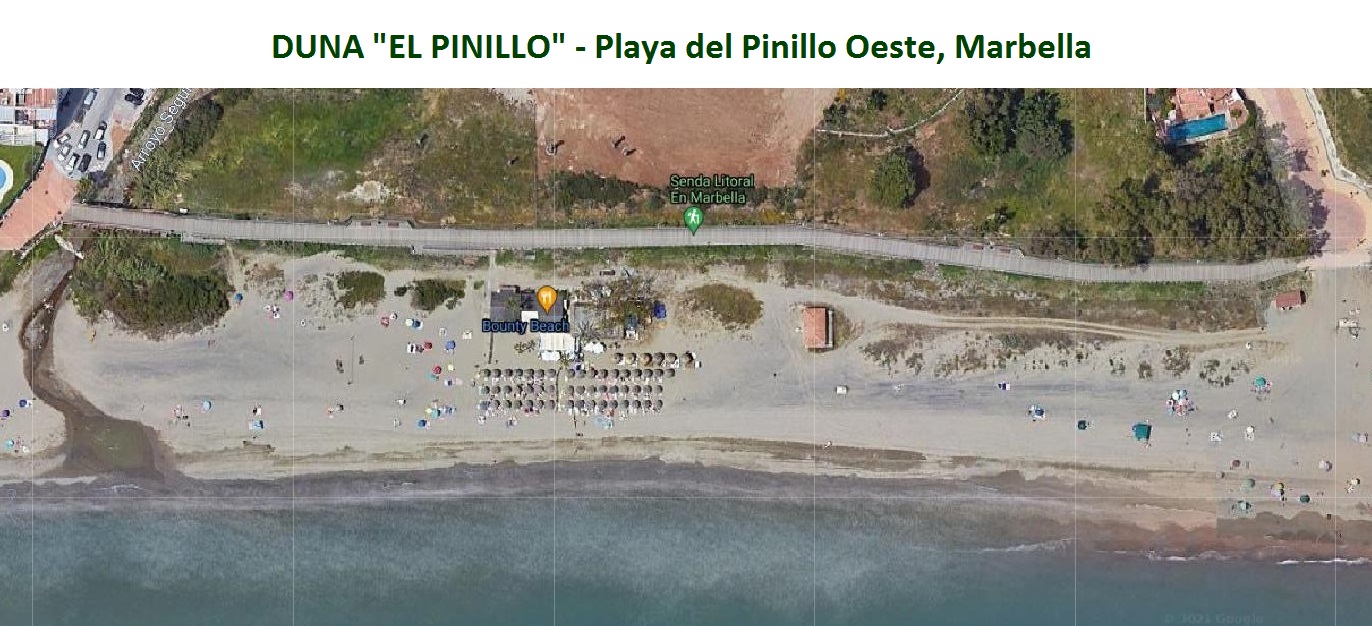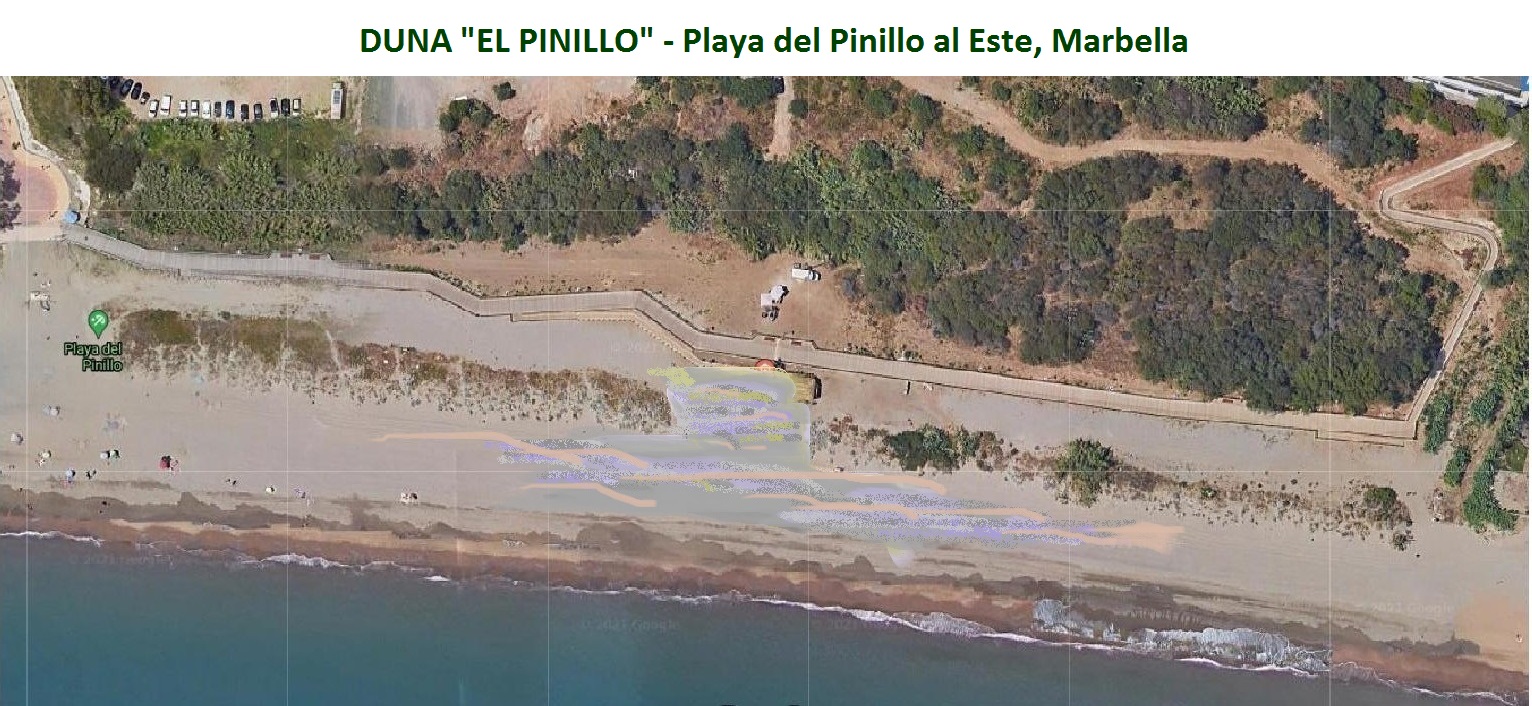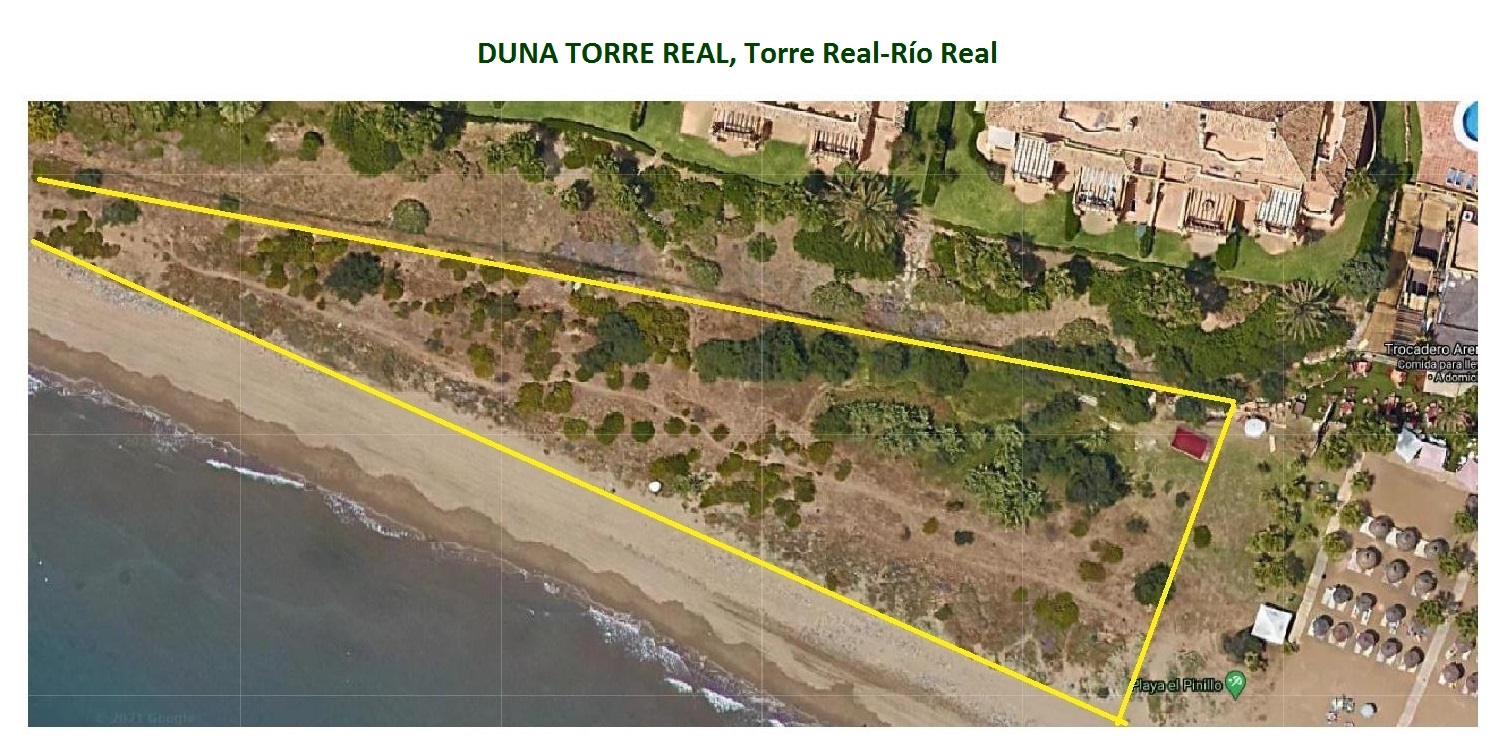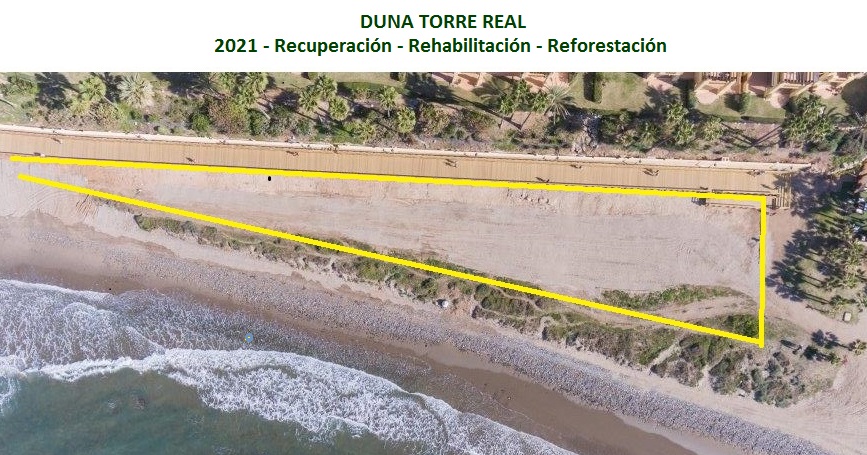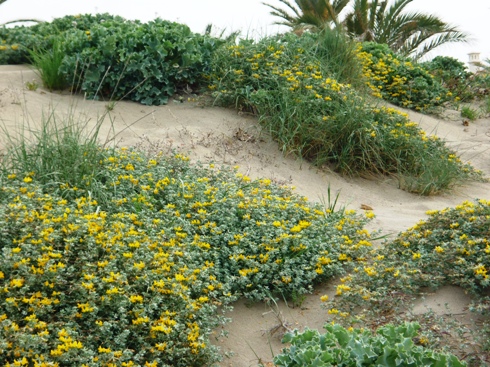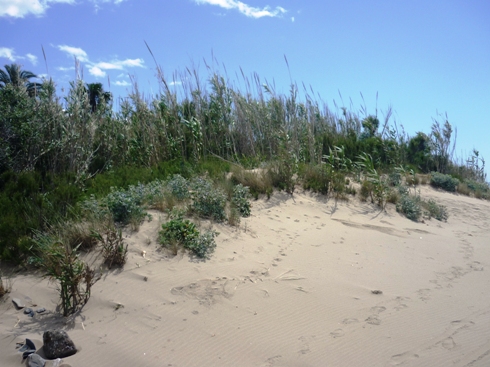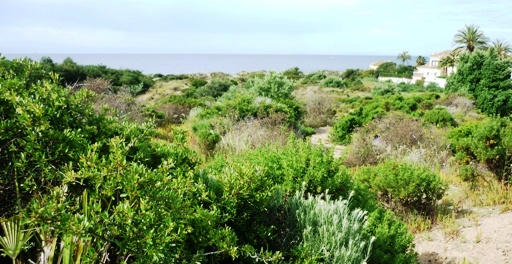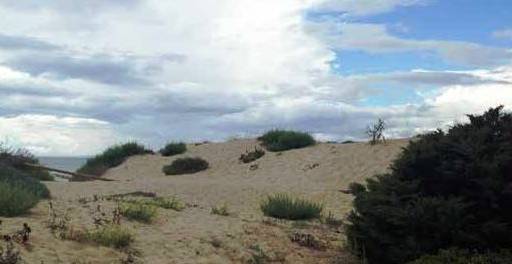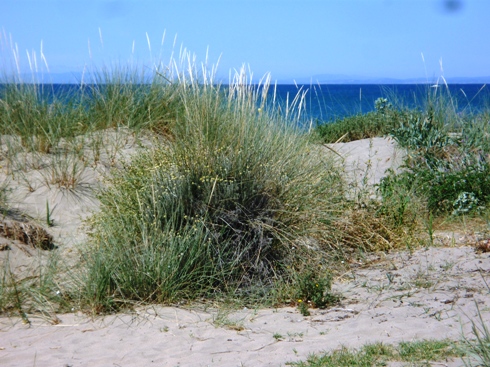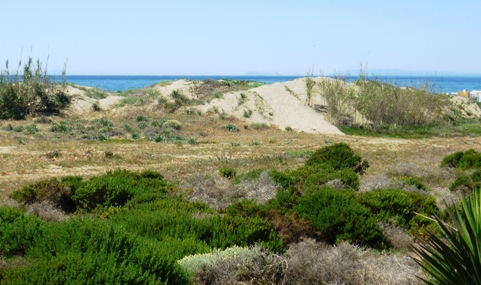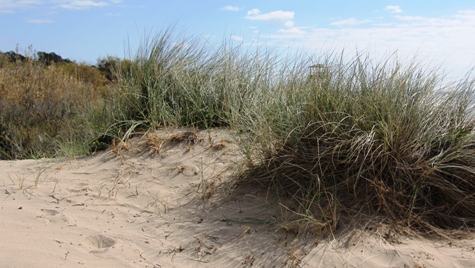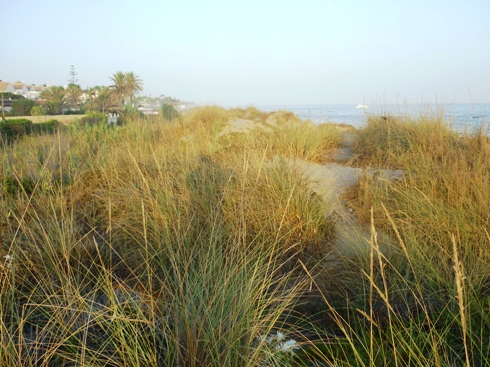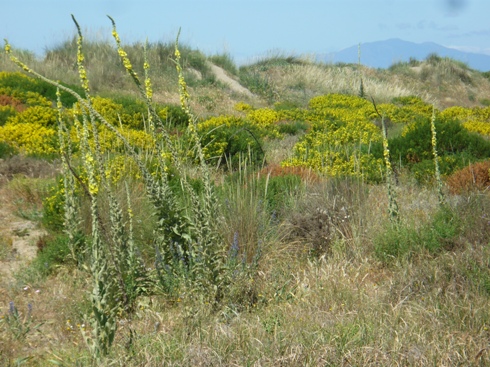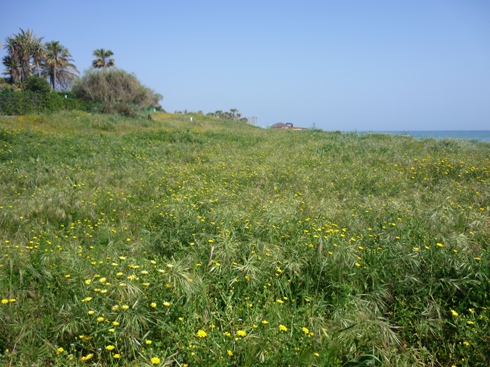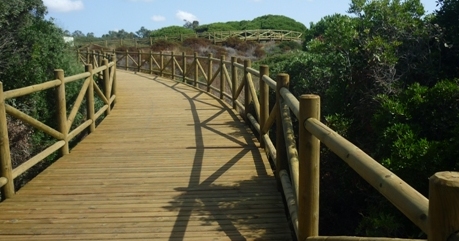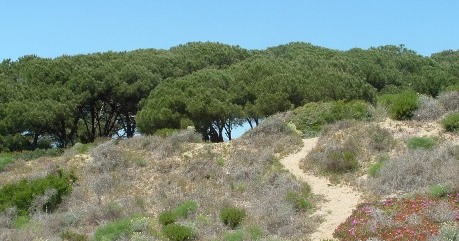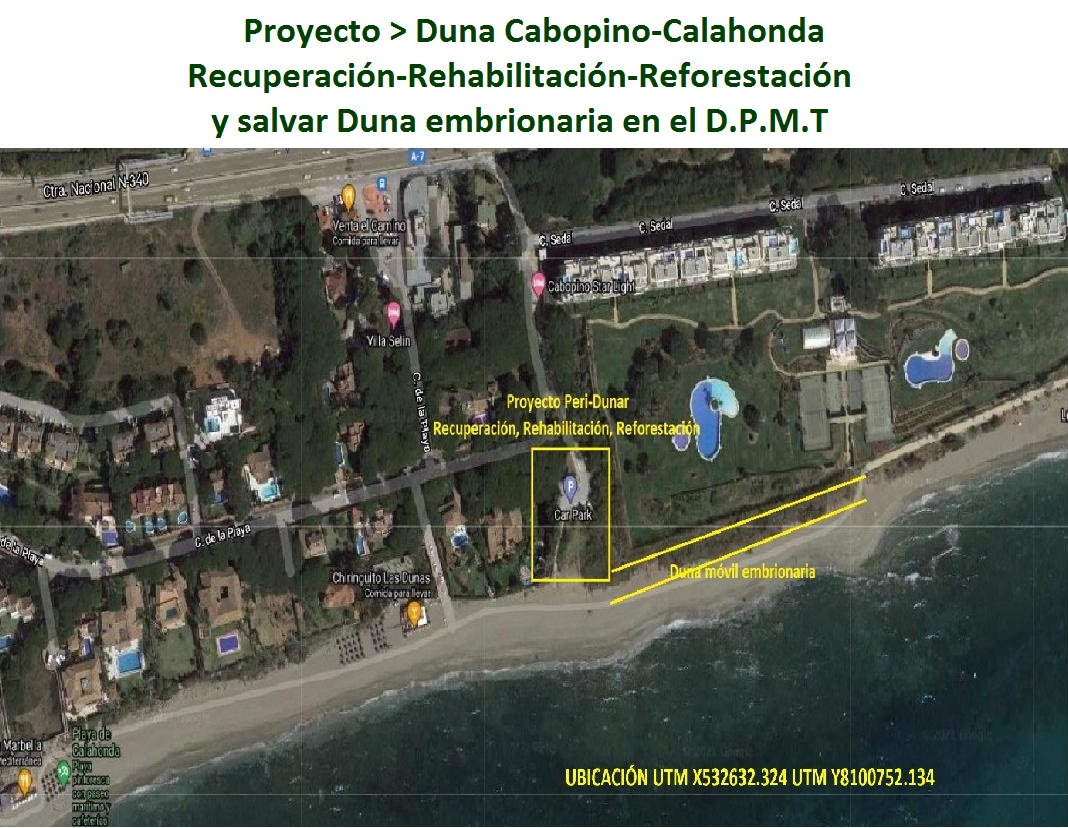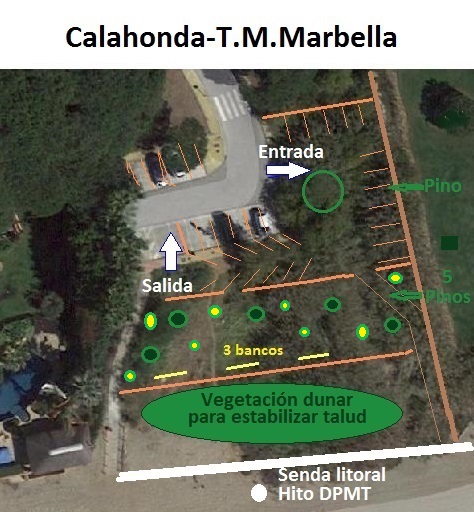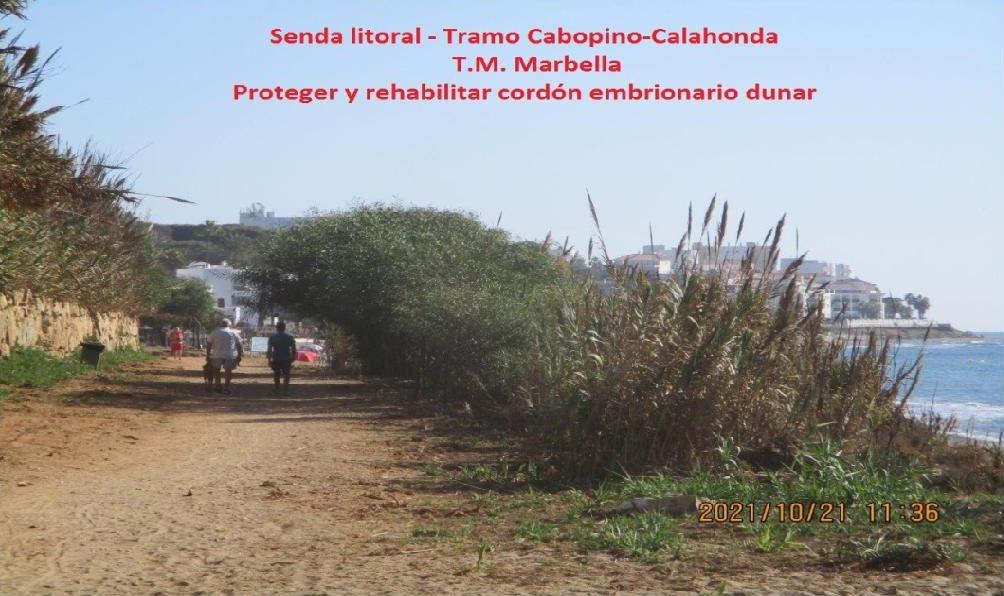THE DUNES
INTRODUCTION
The Natural Heritage of Andalusia has 500,000m² of different rehabilitated dune ecosystems in the Townland of Marbella, between Marbella East and Cabopino.
2003 – NATURAL MONUMENT “DUNAS DE ARTOLA”, CABOPINO – 200,000m²
2015 – THE 9 DUNES SYSTEMS WERE DECLARED “ECOLOGICAL RESERVE-DUNAS DE MARBELLA” – 223,303,68m²
2021 – 3 NEW DUNE SYSTEMS ARE IN THE REHABILITATION AND REFORESTATION PHASE
The sand dunes systems on the coastal zones of Marbella are remnants of the primeval sand dune cord, which, in the past, extended along the coastal strip of Marbella’s seashore. Together with the sand dunes of Artola at Cabopino these are the best preserved dunes in the province of Malaga.
We are talking about a succession of dune formations which, since the middle of the last century have changed profoundly. The dunes were treated very badly and were divided up unnaturally to satisfy the needs of the building boom. The current massive development of beach bars that unfortunately has been allowed, most of them inside dune limits, as the Maritime Terreestrial Public Domain (D.P.M.T). This dune ridge extends from the mouth of the stream Segundo, Marbella to the East of the Cabopino harbour.
They represent a natural enclave within the Mediterranean dune systems, forming a barrier parallel to the coastline and the and urban developments. In the future they will act as a barrier against rising sea levels and will protect the buildings in the areas along the dune boundaries. All dune areas have vegetation specially adapted to sandy substrates but each is distinguished by its uniqueness in the different soil formations.
Mixed in with the native flora are typical scrub and shrub species of the Mediterranea basin such as:Stone Pine (Pinus pinea), Juniper (Juniperus phoenicea turbinata), Wild Olive (Olea europaea), Mastic (Pistacia lentiscus), Black Hawthorn (Rhamnus oleoides) and Palmetto (Chamareops humilis), together with Cork Oak (Quercus suber), the Evergreen Kermes Oak (Quercus coccifera), Broom (Retama monosperma blanca), Rosemary (Rosmarinus officinalis) and Thyme (Thymus).
The dunes typically have three different ecosystems: the first line is formed by mobile sand dunes that protect it from erosion caused by the wind and serves as the habitat of species such as Sea Holly (Eryngium maritimum), European Marramgrass (Ammophila arenaria) and the sea daffodil (Pancratium maritimum).
These species retain the sands dragged by the wind and enrich with organic matter the soil of the second eco-system, the semi-fixed sand dunes. Here is where species such as the goldilocks (Helichrysum stoechas), Espuela de caballero (Delphinium nanum), Toadflax (Linaria pelisseriana), Sea Wallflower (Malcolmia littorea), the Cotton Weed Plant (Otanthus maritimus), the Sea or Cretan Trefoil (Lotus creticus) and many more can get a foothold.
Finally we have the fixed dunes, which are inhabited by large-sized woody plants such as the Pine tree, the Mastic tree or the wild Olive tree, etc.etc.
These dunes are ideal habitats for different species of birds such as the European Greenfinch (Carduelis chloris), the Chaffinch (Fringilia coelebs) and the European Goldfinch (Carduelis carduelis) and other small animals such as the Red-tailed spiny-footed Lizard (Acanthodactylus erythrurus), the rabbit or the European hedgehog.
The shooting and/or capture of birds of the Finch family is forbidden everywhere on the dunes from East Marbella to de “Dunas de Artola” Natural Monument in Cabopino. The Ministry of the Environment issues the relevant decrees on a yearly basis.
In recent years threatened species such as as the Snowy Plover (Charadrius alexandrinus) and the Thekla Lark (Galerida theklae) have returned as different habitats and ecosystems recover.
One of the threats to these sand dunes are the invasive alien species. These plants were introduced into the dune ecosystem a long time ago either by accident or intentionally and are characterized by invading and choking the native species to their eradication, will lead to a significant loss of biodiversity. Ever since the Pro Dunas Association has come into being, grubbing out and/or eradication programs have been taking place annually.
The Pro Dunas Association Marbella is very active in organizing activities y events to promote the conservation and protection of the dunes and their unique morphology. Its objective is the recovery and rebalancing of the different ecosystems.Environmental recognition has been awarded (September 2015 – Resolution by the Environment Ministry of the regional Government) by the Constitution of the ECOLOGICAL RESERVE – MARBELLA DUNES in the municipality of Marbella (Málaga). In virtue of the Art. 11 of the decree 23/2012, 14th February, the conservation and sustainable use of the flora and fauna and its habitats are now regulated.
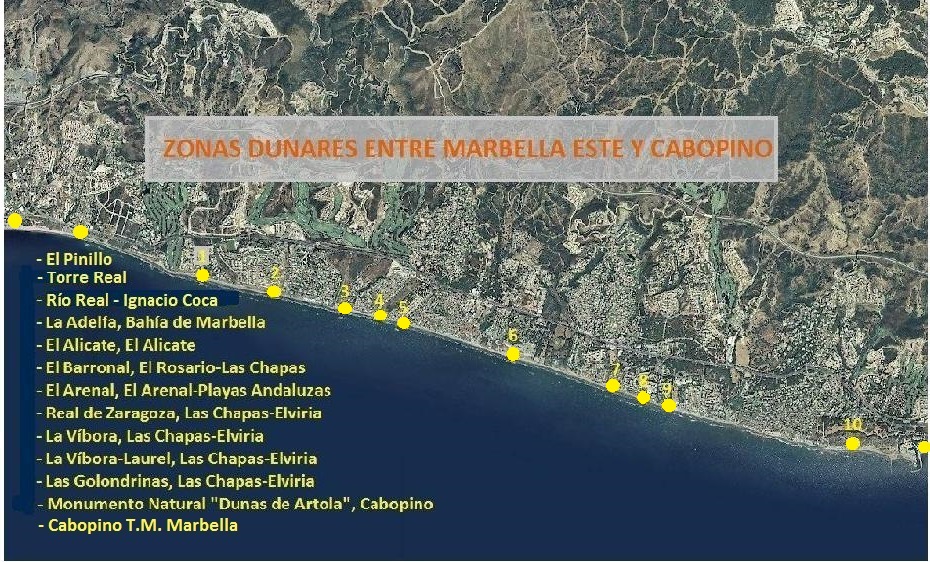
DUNE AREA ‘EL PINILLO’ – PINILLO BEACH, MARBELLA
Pending the application and procedure to be included in the Ecological Reserve-Dunes of Marbella
Year 2021 – The El Pinillo dune is a dune with incipient psammophilous vegetation, typical of the Mediterranean coastal dune environment. The native species that can be found on this embryonic dune are Ammophila arenaria, Euphorbia paralias, Pancratium maritimum, Sonchus maritimus, Eryngium maritimun, among others. It is true that until now, exotic invasive species (Acacia salicina, Agave americana, Arundo donax, Carpobrotus edulis) predominated, which, due to the lack of dune conservation, have been proliferating and gaining territory over the native plants. It is for this reason that the time has come for the recovery and rehabilitation of this dune to be proposed for inclusion in the Marbella Dunes Ecological Reserve.
Morphologically, the El Pinillo dune corresponds to the beginning of a mobile dune, with its corresponding displacement regime. However, the presence of dune vegetation and its consolidation in the dune environment provides sufficient stability for its permanence over time. For this reason, the ProDunas Marbella Association proposes these conservation works, protecting the dune perimeter with chained stakes.
This project is evolving favourably, to the benefit of the municipality of Marbella. Its location is in a favourable point for passers-by, as the slope is situated to the north (Protection Easement) and the dune cordon is located to the south. The coastal path should protect this embryonic dune and prevent trampling by passers-by and prevent the passage of motorised vehicles.
The first works have already been carried out on one third of the dune ridge. During the summer, further work will be carried out to clear the Willow acacia (Acacia salicina/saligna) and Giant cane (Arundo donax) to the east of the dunes. The western part will be rehabilitated from autumn-winter 2021.
It is a project that is being carried out in conjunction with the Environment and Beaches Delegation of the Marbella Town Hall.
DUNE AREA ‘TORRE REAL’, Torre Real – Rio Real
Pending the application for inclusion in the Ecological Reserve-Dunes of Marbella.
Year 2021 – From Asociación ProDunas Marbella we seek to take care of and raise the Torre Real dune area, a small dune stronghold that languished between the sea and the Río Real urbanization, urging the Hon. Marbella City Council to include it in the Marbella Dunes-Ecological Reserve, in order to continue enriching the Natural Heritage of the Marbella municipality.
Unfortunately, the works on the Coastal Path have completely destroyed this dune environment and now, from the ProDunas Marbella Association, we must implement a tedious protocol to regenerate the native dune vegetation:
RECOVER – REHABILITATE – REFOREST
In spring 2021, we went together with the ProDunas Marbella Volunteers to the Torre Real dune, to eradicate the invasive species that, quickly and uncontrollably, threatened this small, but important dune, not only for the Association but also for the Marbella coastline. However, when trying to carry out these activities, we found that the works on the coastal path had compacted the soil.
From our Association we seek the support of experts to know, through reliable and scientific data, what is the correct process to guarantee the survival and subsequent development of this dune environment. That is why, in September 2021, ProDunas Marbella contacted the Geomorphology and Soils Laboratory of the University of Malaga to carry out soil tests in order to carry out a Report evaluating the quality and suitability of the same, to act correctly in relation to the recovery and conservation of this dune.
Attached Report in pdf with our thanks to the Professors / Researchers of the UMA < link to pdf
DUNE AREA ‘RÍO REAL’ – Río Real and Reserva de los Monteros
This beautiful dune area covers approx. 15.000m2 and its crest can reach a height of about 2 – 4m. It has a length of about 400m, parallel to the beach and a depth towards the different urbanisations of about 30 – 40m. This dune area is located between the mouth of the Rio Real stream and the different urbanisations, near the Realejo stream.
It consists of three sections: Palm Beach, Los Monteros Playa and Ignacio Coca. The continuity of the dune ridge has been interrupted due to the installation of the Palm Beach beach bar. In 2012, the Coastal Demarcation carried out an in-depth mechanical clearing of the invasive exotic plants in the first section, which had completely displaced the native flora due to their predatory power. Subsequently, it was rehabilitated by replanting several hundred native shrub species such as Sabina, mastic, black hawthorn, Acebuche, etc.
Volunteers from the Pro Dunas Association take care of the reforestations carried out, with weekly watering, until their rooting is guaranteed. Likewise, the students of the Sierra Blanca Secondary School, who sponsored the first section of this dune area, collaborate periodically in its maintenance.
DUNE AREA “LA ADELFA”, Bahía de Marbella
It is an interesting dune environment which, due to the variety of native wild flora it contains, is populated by a great diversity of small wild fauna. It covers about 45.000m2 and its dune crest can reach a height of about 2-4m. It is about 1.000m long parallel to the beach and has a depth towards the Urbanisations of about 30-50m.
This dune area stretches from the Realejo stream to the Los Monteros housing estate. It is the first dune area that the Asociación Pro Dunas saved from destruction more than 10 years ago.
Several reforestations with autochthonous shrubs have been necessary for a correct recovery and rehabilitation, including Phoenician juniper (Juniperus phoenicea subsp. turbinata), Mastic (Pistacia lentiscus), Wild olive trees (Olea europaea), Stone pines (Pinus pinea), Cork oaks (Quercus suber), Rosemary (Rosmarinus officinalis) and palm hearts (Chamaerops humilis).
Thanks to the intensive care during the first three years by ProDunas Marbella volunteers, the small plants have evolved perfectly, creating a bio-habitat typical of a sandy environment, which has attracted small fauna and fringillid birds.
Every year a strict control is kept on the possible resprouting of invasive exotic species. Pupils from the ECOS-Attendis School have sponsored this dune area and carry out annual maintenance days.
DUNE AREA “EL ALICATE”, El Alicate-Las Chapas
This small dune formation covers approx. 8,000m2 and is about 200m long and runs parallel to the beach. It is located between the Siete Revueltas and Alicate streams and more specifically between the Oyana and Los Sardinales beach bars. It is about 30 – 40m wide, between the beach and the Transit Easement. Since 2013 we have been carrying out conservation work with very good results. This dune environment is practically rehabilitated and is starting to become autochthonous.
Due to the large proliferation of an existing reed bed, the ProDunas Association plans to eradicate Giant cane (Arundo donax) during the winter of 2015-2016, as well as other invasive plants such as: American century plant (Agave americana), Willow acacia (Acacia saligna), Eucalyptus (Eucalyptus).
Concatenated stakes help preserve the dune system, preventing transgression by beach-going residents.
DUNE AREA “EL BARRONAL DE LA MORENA”, El Rosario-Chapas
It is one of the most beautiful and authentic dunes on this stretch of the Marbella coastline. It covers about 36.000m2 and its crest currently reaches a height of about 5 – 8m. It has a length of approx. 200m, parallel to the beach. It has a depth with a pronounced orography of valleys and dune crests of approx. 200m in a north-south direction. This dune is exceptional due to its perpendicular shape to the coast, nestled between the Las Chapas and Playas Andaluzas developments. It consists of an ecosystem (geosigmetum) belonging to the ancient band of dunes that used to occupy the area between Marbella and Cabopino.
In this dune there are several ecosystems depending on the proximity or distance to the sea and it is of great interest for its varied development of the autochthonous flora and groups of small fauna. There is an abundance of Phoenician juniper (Juniperus phoenicea subsp. turbinata), mastic (Pistacia lentiscus), Wild olive tree (Olea europaea), European fan palm (Chamaerops humilis), 2 specimens of Stone pine (Pinus pinea).
In 2009, this dune area has awakened an extraordinary interest, because the Pro Dunes Association had promoted a citizen mobilization, fighting for the survival of almost half of the unique and authentic dune environment, which was about to be destroyed by a future urbanization. Eminent professors were also in favour of the preservation of this dune, because of the palaeobiogeographical information it contains.
Periodic maintenance with eradication of invasive plants such as: Highway Iceplant (Carpobrotus edulis), Willow acacia (Acacia saligna) and Giant cane (Arundo donax) are promoted by ProDunas Marbella, to guarantee the wild development of the vegetation. The pupils of the Alborán School have sponsored this magnificent environment and collaborate annually with maintenance work.
Elevated pedestrian walkways on both sides of the dune will allow access to the beach in the near future, respecting the existing vegetation and wildlife habitat.
DUNE AREA “EL ARENAL” – Costabella-Las Chapas
This is an outstanding dune area covering approx. 9,000m2. It has two independent crests with a height of between 4 – 5m high. It is approx. 200m long, parallel to the beach and is about 30 – 50m deep, depending on which section we are talking about. This dune environment is to the west of the “Bono’s Beach” restaurant and between the “El Arenal” beach restaurant and the access path to the beach from the Playa Andaluzas development.
Both sections are recovering. The school children of the Secondary IES Salduba School in San Pedro Alcantara have sponsored this beautiful dune and they keep it free of the invasive alien species Highway Iceplant (Carpobrotus edulis). In 2015 they reforested the first stretch with native shrubs such as: Mediterranean Fan Palm (Chamaerops humilis), Juniper (Juniperus phoenicea subsp turbinata.), Mastic (Pistacia lentiscus), Broom (Retama sphaerocarpa), Rosemary (Rosmarinus officinalis) and Thyme (Thymus). Volunteers from the Pro Dunas Association are looking after the tiny plants, watering them manually once a week to ensure they root properly.
In the second section we eradicated American century plant (Agave americana), some Willow acacia (Acacia saligna) and some stands of Crimson fountain grass (Pennisetum setaceum) to let the local flora develop naturally.
Wooden stakes interconnected by sisal rope have been erected around the dune area to increase its protection. Thanks to this initiative, the native dune plant par excellence – the European marran grass (Ammophila arenaria) is developing beautifully, anchoring the crest of the dune.
DUNE AREA “REAL DE ZARAGOZA”, Las Chapas-Elviria
This area is located between the Sequillo and Real de Zaragoza streams. Due to the enormous extension of this area, we have divided it into 4 sections:
Section 1: from the Sequillo stream – Chiringuito Siroko Beach (former Ola del embarcadero) to the pumping station next to Chiringuito Sylt.
Section 2: between Chiringuitos Sylt and Ranchón Cubano.
Section 3: between the Chiringuitos Ranchón Cubano and Las Mimosas.
Section 4: between Chiringuitos Las Mimosas and Casanis > Real de Zaragoza stream.
This environment presents a great anthropised degradation in sections 1 – 3, caused by irresponsible motorised transgression over the years and the introduction of invasive plants. Even so, there is a unique dune ridge of about 70.000m2 with ridges that can reach a height of about 2 – 4m. The whole area between the two streams has a length of about 1.500m, parallel to the beach and a depth with the street (Transit Easement) of about 50 – 70m., interrupted by beach bars that are located in the middle of the dune ridge as well as private properties in section 4.
This dune area is sponsored by the students of IES Dunas de las Chapas and IES Profesor del Saz, who collaborate annually in dune conservation. Other dune conservation days are organised by the Asociación Pro Dunas in order to control the proliferation of the powerful invasive plants.
In the year 2024 the Marbella Town Hall has installed an elevated pedestrian walkway across the entire Public Maritime Terrestrial Domain (D.P.M.T), between the beach bars Las Mimosas and Siroko. The aim is to ensure that this interesting dune ecosystem can continue to develop with the help of regular dune conservation and maintenance work carried out by the volunteers and the educational centres that have sponsored this dune area.
DUNE AREA “LA VÍBORA-OESTE”, Las Chapas-Elviria
This dune area belongs to the dune cordon of yesteryear. The urban development abuse has left a 250m long dune with a ridge and small valleys of about 3m high and about 50m deep between the beach and the Urbanisations. Originally it joined the stream La Víbora to continue towards Marbella. Nowadays its evolution is cut off by the Chiringuito Beach House and the access to the beach from the car park La Víbora.
This dune area receives annual rehabilitation works with eradication days of the invasive exotic species Highway Iceplant (Carpobrotus edulis) that ProDunas Marbella programmes with groups of volunteers and/or with pupils from a school. On the plain behind the dune ridge, maintenance work is carried out annually to remove resprouts of the invasive species Willow acacia (Acacia saligna) and Giant cane (Arundo donax).
Thanks to the initiative of ProDunas Marbella, wooden stakes with plant rope have been placed on the dune perimeter, between the beach and the dune.
DUNE AREA “LA VÍBORA–ESTE”, Las Chapas – Elviria
A beautiful dune with an intact dune ridge with a height of approx. 6m, which acts as a parapet against the advancing sea and against winter storms or currents. It has an area of about 22,500m2. It has a length of about 450m and a depth towards the different Urbanisations of about 50m. This environment is squeezed between two Chiringuitos El Laurel and Perla Blanca. The dune perimeter has been protected by means of stakes linked with plant rope.
In 2012 recovery and rehabilitation work began, due to the large proliferation of invasive exotic plants. Subsequently, reforestation was carried out at different times. Schoolchildren from secondary schools in Marbella and Mijas were initiated in environmental education, planting small native shrubs such as: Phoenician juniper (Juniperus phoenicea subsp. turbinata), Mastic (Pistacia lentiscus), Olive-leaved buckthorn (Rhamnus oleoides), Wild olive (Olea europaea), Cork oak (Quercus suber), Kermes oak (Quercues coccífera), European fan palm (Chamaerops humilis).
The schoolchildren of the Platero School (primary school) in Las Chapas have sponsored this environment and participate annually in an environmental day. Volunteers from the ProDunas Marbella Association continue to look after an interesting existing biodiversity.
DUNE AREA“LAS GOLONDRINAS”, Las Chapas-Elviria
This dune area is located between the Chiringuitos El Laurel and Tony’s and is still in the process of conditioning and rehabilitation. The area is part of the old dune belt, although the whole surface is currently very degraded, due to the enormous urban development pressure it suffered in the past. It is about 250m long with a height from the beach of about 3-4m.
In 2014 a first clearing of the Willow acacia (Acacia saligna) and the Giant cane (Arundo donax) was carried out to allow the development of the wild-native flora. A wooden pedestrian footbridge is planned to be installed in the traffic easement. Subsequently, an appropriate restoration and reforestation with autochthonous bushes will be carried out, programmed by Pro Dunas.
Due to the repeated storms, the initiative of ProDunas Marbella to place wooden stakes with a string of vegetation along the entire dune perimeter, between the beach and the dune, has been rendered useless.
Along the dune in the Transit Easement, the Marbella Town Hall has installed a wooden footbridge.
The German School of Las Chapas-Elviria has sponsored this environment and collaborates in environmental conferences.
ProDunas Marbella is promoting a Bird Watching Point to observe the migratory birds as well as the cetaceans (Dolphins) that pass by every day with their families.
NATURAL MONUMENT “DUNAS DE ARTOLA”, Cabopino
The Artola Dunes were declared a Natural Monument in 2003 because of their significant natural value with an intact ecosystem and varied biodiversity. This dune environment is 20,000 m² and even today testifies to how the natural coastline of Marbella looked not many years ago.
This privileged region has three types of dunes. At the beachfront the dunes are mobile and because of their rippled surfaces can easily be spotted. The second line forms a natural barrier with inactive but mobile dunes, covered with shrub vegetation and by indigenous flora of great interest. Farthest from the sea are inactive, fossil dunes, with a narrow band of dense Stone Pine (Pinus pinea) as well as common shrubs such as Juniper (Juniperus sabina supsc. turbinata), Mastic (Pistacia lentiscus) and wild Olive tree (Olea europaea), typical species in the Mediterranean area which provide shelter and food for birds and small animals as well as for the typical Mediterranean scrub.
The interesting dune vegetation includes specific dune species such as European Beachgrass (Ammophilia arenaria) and Sea Holly (Eryngium maritimum). There are clumps of Bitter Chamomile (Helichrysum stoechas) and a myriad of wild flora which varies from season to season. The Sea Daffodil (Pancratium maritimum) blooms in all its glory between the most dry months: July and September.
Pedestrian walkways guarantee the total protection of the area, protecting it from constant trampling by members of the public thus allowing the natural development of the native flora. The tower known as La Torre Ladrones at the edge of Cabopino Harbour is 16 m high and was formally used as a military watchtower. Its origin seems to date back to Roman times and it was rebuilt over the centuries by both Arabs and Christians. This beacon has been declared of Cultural Interest and is kept in good condition.
Pro Dunas will continue to maintain the dunes with the help of school groups. Schools from other Provinces are welcome.
THE CABOPINO-CALAHONDA DUNE
Dune environment undergoing recovery, rehabilitation and reforestation.
Years 2024-2021 – We are programming different works of conservation and recovery of the dune vegetation, thanks to the collaboration of university students and volunteers.
The coastal path links up with the coastal path in the municipality of Marbella.
Stakes are placed along the entire dune perimeter, both on the side of the coastal path and on the beach.
Once all the work has been completed, we will take the necessary steps to ensure that this new dune area is included in the Ecological Reserve-Dunes of Marbella.
Do you want to receive our Newsletter?
Do you want to become a member or be our friend of the dunes?
Asociación ProDunas Marbella
La Asociación trabaja incesantemente en defensa y preservación de los singulares ecosistemas aún existentes en los entornos naturales con dunas en la Provincia de Málaga; impulsa la protección de su flora autóctona y pequeña fauna silvestre; fomenta la recuperación, rehabilitación y conservación de la interesante biodiversidad en las zonas dunares del municipio de Marbella.
+34 609 600 706
comunicacion@produnas.org



